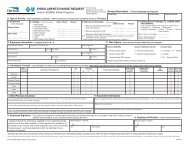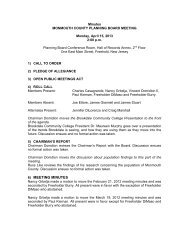NATURAL and CULTURAL FEATURES of MONMOUTH COUNTY
NATURAL and CULTURAL FEATURES of MONMOUTH COUNTY
NATURAL and CULTURAL FEATURES of MONMOUTH COUNTY
Create successful ePaper yourself
Turn your PDF publications into a flip-book with our unique Google optimized e-Paper software.
In 1970, when the Clean Water Act was passed, there were 39 sewer treatment plants<br />
discharging into the ocean <strong>of</strong>f NJ, none <strong>of</strong> which provided secondary treatment; by 1988, there<br />
were 13 plants, all <strong>of</strong> which provide at a minimum secondary treatment <strong>and</strong> chlorination<br />
(NJDOH, 1990). The last primary treatment plant in the County to discharge sewage a few<br />
hundred feet past the swimming zone was taken out <strong>of</strong> service in Asbury Park in 1988.<br />
Currently there are 7 sewage outfalls in the County from S<strong>and</strong>y Hook to South Belmar, mostly<br />
constructed during the 1960’s <strong>and</strong> 1970’s, that discharge secondary or tertiary treated sewage<br />
into the ocean at flows rated from 4.4 to 33 million gallons per day (MGD) from 1500 to 5800<br />
feet <strong>of</strong>fshore.<br />
The County’s Bayshore <strong>and</strong> ocean beaches are closest to the 700 Combined Sewer Overflows<br />
discharging into the NY/NJ Harbor or to its tributaries, 250 in NJ <strong>and</strong> 450 in NY (<strong>and</strong> some in<br />
Connecticut), that legally discharge sewage into the Hudson-Raritan Bay complex (Gaugler,<br />
2006; HEP, 2005). As little as 0.04” per hour <strong>of</strong> rain in NYC can overload the capacity <strong>of</strong> a<br />
sewer plant <strong>and</strong> cause a bypass <strong>of</strong> sewage into the Bay (EPALISO, 2009). Since 1936, the<br />
Interstate Environmental Commission has been m<strong>and</strong>ated to protect the Tri-States’ region’s<br />
waters (http://www.iec-nynjct.org/ ).<br />
Many CSOs in NJ are now screened with “Net Capture” or other devices to retain floatables,<br />
which include fecal material congealed in cooking grease <strong>and</strong> soap known as ‘greaseballs’ or<br />
‘sewage cakes’ when they are found in the wrack line. The total number <strong>of</strong> CSO's in all <strong>of</strong> NJ<br />
had been 275, but as <strong>of</strong> 2009 there were 222. This includes CSO's in southern NJ on the<br />
Delaware River, in Camden County <strong>and</strong> in Trenton in Mercer County. However as <strong>of</strong> 2009 in<br />
northern NJ in the Hudson-Raritan Bay watershed, there were 187 CSO's, 156 (83%) with<br />
solids/floatable controls like Netcapture; the remainder are in design/construction phase. The<br />
original number <strong>of</strong> CSO's in NJ has been reduced by about 20%, from 275 to 222; 52 were<br />
eliminated when municipalities like New Brunswick <strong>and</strong> Rahway eliminated their CSOs by<br />
converting to modern dual systems (separate storm water <strong>and</strong> sanitary sewer) (Olko, 2009). The<br />
most southern CSOs on NJ’s Atlantic coast are the 9 in Perth Amboy on the Raritan River<br />
estuary in Middlesex County.<br />
In contrast, NYC has screened few <strong>of</strong> their 450 CSOs, relying instead on open water skimmer<br />
vessels to catch floatables after they have been discharged into the bay (Gaugler, 2006; Meakim,<br />
2005). NYC’s yearly average <strong>of</strong> 43" <strong>of</strong> rain causes about 27 billion gallons <strong>of</strong> untreated<br />
stormwater <strong>and</strong> sewage to be discharged from these CSOs in a year (Riverkeeper, 2009). This<br />
means that almost 63 million gallons <strong>of</strong> untreated CSO waste is discharged into the Bay from<br />
NYC for every tenth <strong>of</strong> an inch <strong>of</strong> rainfall.<br />
Geology <strong>and</strong> Structures<br />
Beach s<strong>and</strong>s generally become whiter <strong>and</strong> coarser from north to south; this is because silt <strong>and</strong><br />
clay formations outcrop along Raritan Bay <strong>and</strong> the northern coast, while the heavier Kirkwood-<br />
Cohansey s<strong>and</strong>s dominate beaches from Asbury Park south. Geology is one reason why the<br />
ocean in northern Monmouth is usually not as blue as it is by Manasquan. The dappling that<br />
occurs on the surface <strong>of</strong> flowing water happens because bright convex parts rise <strong>and</strong> focus<br />
sunlight, while dark concave parts dip <strong>and</strong> diffuse the light (Ross, 2000).

















